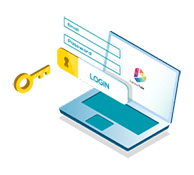In a world that moves faster than ever, communicating instantly and effectively isn’t just an advantage—it’s a necessity. For businesses using digital signage, this means moving beyond static, pre-scheduled content. It’s time to embrace the transformative power of real-time information.
So, what exactly does “real-time” mean in the context of digital signage? It refers to displaying content that is automatically and instantaneously updated from an external data source. This could be anything from live news feeds and social media walls to current weather forecasts and public transit schedules. This dynamic approach ensures that the information on your screens is always current, accurate, and highly relevant to your audience at any given moment.
This guide explores the significant benefits of integrating real-time data into your digital signage strategy. From boosting engagement to streamlining operations, discover how dynamic content can revolutionize your communication efforts and give you a critical competitive edge.

Real-Time Digital Signage: A Guide to Dynamic Content
Why Use Real-Time Content? The Core Benefits
Integrating live data into your digital signage isn’t just about looking modern; it’s a strategic move that delivers tangible results. By providing timely and relevant information, you can capture attention more effectively and create a more valuable experience for your audience. Let’s look at the key benefits.
Boost Audience Engagement
Static content can quickly become part of the background, easily ignored by people passing by. Real-time information, on the other hand, is dynamic and constantly changing, making it inherently more interesting. Imagine a screen in a coffee shop displaying a live Twitter feed with customer photos or a retail store showing the latest flash sale details. This type of content grabs attention because it’s current and interactive.
When viewers know they can find up-to-the-minute information on your screens, they are more likely to pay attention. This increased engagement makes your messaging more impactful and memorable.
Enhance Relevance and Value
The most effective communication is that which is most relevant to the audience. Real-time digital signage allows you to deliver content that speaks directly to your viewers’ immediate context and needs.
Consider these scenarios:
- An airport screen displaying live flight departure and arrival times.
- A university campus screen showing today’s event schedules and room changes.
- A restaurant menu board that automatically updates to show which items are sold out.
In each case, the information is not just interesting—it’s genuinely useful. By providing valuable, real-time data, you transform your digital screens from simple advertising tools into indispensable resources for your audience.
Increase Operational Efficiency
Beyond their undeniable ability to captivate audiences, real-time digital signage solutions offer significant efficiency benefits. Automating content updates saves your team valuable time and reduces the chance of human error.
Instead of manually updating displays with new information, you can link your screens to a data source that does the work for you. For example, a corporate office can connect its signage to a shared calendar to automatically display meeting room schedules. A manufacturing plant can show live production metrics pulled directly from its internal systems. This automation frees up your staff to focus on more strategic tasks, streamlining operations and boosting productivity across the board.
Practical Applications of Real-Time Digital Signage
The potential uses for real-time digital signage are vast and span across numerous industries. How could you apply this technology in your own organization? Here are some inspiring examples to get you thinking.
Corporate Communications
In a large organization, keeping everyone informed can be a challenge. Real-time digital signage is a powerful tool for internal communications.
- Live KPIs: Display key performance indicators (KPIs) and business dashboards in offices to keep teams aligned on goals and progress.
- Meeting Schedules: Sync screens outside meeting rooms with calendar systems like Google Calendar or Outlook to show real-time availability.
- Internal News: Share company announcements, employee spotlights, and important updates instantly across all locations.
Retail and Hospitality
For customer-facing businesses, real-time content can directly influence purchasing decisions and improve the customer experience.
- Dynamic Pricing: Automatically update prices based on demand, time of day, or inventory levels.
- Live Social Media: Showcase a live feed of social media posts from happy customers to build social proof and community.
- Menu Boards: Connect digital menu boards to your point-of-sale (POS) system to reflect item availability and promote daily specials automatically.
Education and Healthcare
In environments where timely information is critical, real-time signage is indispensable.
- Emergency Alerts: Instantly broadcast emergency notifications and safety instructions across a campus or hospital.
- Wayfinding: Provide interactive maps that update with temporary closures or route changes.
- Wait Times: Display estimated wait times in hospital waiting rooms or university administrative offices to manage expectations and reduce perceived wait times.
Transportation Hubs
Airports, train stations, and bus terminals are prime locations for real-time digital signage.
- Arrivals & Departures: Show live-updated schedules for flights, trains, and buses.
- Weather Forecasts: Display current weather conditions and forecasts to help travelers prepare for their journey.
- Traffic Updates: Provide live traffic maps and information on road closures or delays.
Getting Started with Real-Time Content
Ready to bring the power of real-time data to your digital screens? Getting started is more straightforward than you might think. Modern cloud-based digital signage platforms are designed to make integrating live data feeds simple and intuitive.
1. Choose Your Data Source: First, identify the real-time information you want to display. This could be a public source like a news feed (via RSS), a social media platform, or a weather service. Alternatively, it could be an internal data source like a Google Sheet, a company database, or a calendar application.
2. Select a Capable Digital Signage Platform: Not all digital signage software can handle real-time data. You’ll need a solution that offers integrations (often called “widgets” or “apps”) for the data sources you want to use. Look for a platform with a user-friendly interface that allows you to simply drag and drop these elements into your screen layouts.
3. Design Your Layout: Once you’ve connected your data source, you can design how the information will appear on screen. Good platforms offer customization options, allowing you to match the look and feel of the real-time content with your brand’s colors, fonts, and style.
4. Deploy and Monitor: With your layout complete, you can push the content to your screens. The system will then automatically pull in the latest data, ensuring your displays are always current without any manual intervention.
Your Next Step in Digital Communication
The shift from static to real-time content is more than just a technological upgrade; it’s a strategic evolution in how we communicate. By harnessing the power of live data, you can create a digital signage network that is more engaging, relevant, and efficient than ever before.
Providing your audience with information that is valuable in the moment builds trust and transforms your screens into essential touchpoints. Whether you’re looking to streamline internal processes, drive sales in a retail environment, or improve the visitor experience in a public space, real-time digital signage offers a powerful solution.
Are you ready to make your screens come alive? Explore a modern digital signage platform and see for yourself how easy it is to integrate real-time content into your communication strategy. The future of digital signage is dynamic, and it’s happening right now.

